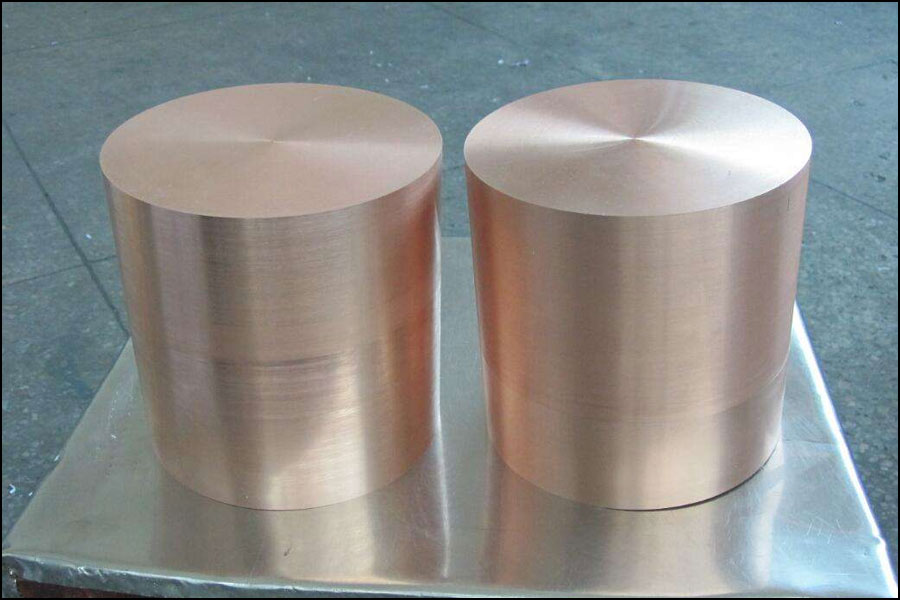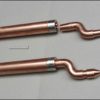
What is molybdenum copper alloy?
Molybdenum-copper alloy is actually a pseudo-alloy composed of two insoluble metals, but it has both the characteristics of molybdenum and copper and has a good overall performance. The main characteristics of Mo-Cu alloy are as follows:
- 1. High electrical conductivity and high thermal conductivity. Molybdenum is an element with good electrical and thermal conductivity in addition to gold, silver, copper and other metals. Therefore, the molybdenum-copper alloy composed of molybdenum and copper has high electrical and thermal conductivity.
- 2. Low adjustable thermal expansion coefficient. Copper has a high coefficient of thermal expansion, but molybdenum has a very low coefficient of thermal expansion. Therefore, in the application, the required lower thermal expansion coefficient can be made according to the combination of different components, so that they can be matched and combined with the thermal expansion coefficient of other materials, and the thermal stress damage caused by the excessive difference in the thermal expansion coefficient can be avoided.
- 3. Special high temperature performance. The melting point of molybdenum is 2610°C, while the melting point of copper is only 1083cC. Molybdenum-copper alloy has good strength and certain plasticity at normal temperature and medium temperature. When the temperature exceeds the melting point of copper, the copper in the material It can liquefy and evaporate to absorb heat and play a cooling role (sweat cooling). This performance can be used as high-temperature materials for special purposes, such as nozzle throat linings that resist the combustion temperature of gunpowder, and electrical contacts under the action of high-temperature arcs.
- 4. Non-magnetic. Both molybdenum and copper are non-ferromagnetic metals, so the formed molybdenum copper alloy is an excellent non-magnetic material.
- 5. Low gas content and good vacuum performance. Regardless of whether it is molybdenum or copper, its oxides are very easy to reduce, and their N, H, C and other impurities are also easy to remove, thus maintaining extremely low outgassing under vacuum and having good vacuum performance.
- 6. Good machinability. Pure molybdenum metal itself is difficult to machine due to its higher hardness and brittleness. Molybdenum-copper alloys are advantageous for machining and can be processed into complex-shaped parts because the hardness of the material decreases and the plasticity increases after adding copper.
Main uses of molybdenum copper alloy
Because of the above-mentioned properties, the application prospect of molybdenum copper alloy is broad. There are:
- 1. Vacuum contacts are currently being promoted and applied in a large area in China
- 2. Conductive heat-dissipating components can meet the requirements of high electrical conductivity, thermal conductivity, heat resistance, vacuum performance and constant thermal expansion coefficient of high-power integrated circuits and microwave devices
- 3. As some special-required instrument and meter components, it can meet its non-magnetic, constant thermal expansion coefficient, high elastic modulus, high electrical and thermal conductivity, etc.
- 4. Used for the use of low-temperature rockets and high-temperature parts of missiles, and can also replace molybdenum as parts in other weapons, such as extended range guns, etc.
- 5. It is used as a reinforcing rib for solid dynamic seal, sliding friction, water-cooled electrode tip of high temperature furnace, and electrode for electrical machining, etc. Its application can be further developed.
Molybdenum copper preparation process
- 1. Liquid-phase sintering method: Tungsten-copper or molybdenum-copper mixed powder is press-formed and then liquid-phase sintered at 1300-1500°. The material prepared by this method has poor uniformity and many closed voids. The density is usually less than 98%. However, ultrafine and nano-powders are prepared by the activation sintering method with a small amount of nickel, mechanical alloying method or oxide supply reduction method It can improve the sintering activity, thereby increasing the density of tungsten copper and molybdenum copper alloys. However, nickel activation sintering will significantly reduce the electrical and thermal conductivity of the material, and the introduction of impurities by mechanical alloying will also reduce the conductivity of the material; the oxide co-reduction method to prepare powders is cumbersome in the process, low in production efficiency, and difficult to mass production.
- 2. Tungsten and molybdenum framework infiltration method: First, tungsten powder or molybdenum powder is pressed into a shape, and sintered into a tungsten and molybdenum framework with a certain degree of porosity, and then copper is infiltrated. This method is applicable to tungsten copper, molybdenum copper products with low copper content. Compared with molybdenum copper, tungsten copper has the advantages of small quality, easy processing, linear expansion coefficient, thermal conductivity and some main mechanical properties equivalent to tungsten copper. Although the heat resistance is not as good as tungsten copper, it is better than some heat-resistant materials, so the application prospect is better. Because the wettability of molybdenum-copper is worse than that of tungsten-copper, especially when preparing molybdenum-copper with low copper content, the density of the material after infiltration is low, resulting in that the airtightness, electrical conductivity, and thermal conductivity of the material cannot meet the requirements. Its application is restricted.






